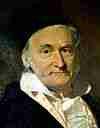 Sitemap
SitemapMobile Math Website
History of Mathematics
Modern Mathematics

Carl Friedrich Gauss
The 19th Century
Modern mathematics, the 19th century, became increasingly abstract. Carl Friedrich Gauss, 1777-1855 AD, provided many contributions to pure science and mathematics. In pure math he contributed revolutionary works for functions of complex variables, geometry and on the convergence of a series. He gave the first satisfactory proofs of the Fundamental Theorem of Algebra and of the Quadratic Reciprocity Law.
During this century two new forms of non-Euclidean geometry were developed extending beyond the parallel postulate of Euclidean Geometry. The Russian mathematician Nikolai Ivanovich Lobachevsky and rival Hungarian mathematician János Bolyai independently defined Hyperbolic Geometry where the summed angles of a triangle are less than 180 degrees.
Later in the 19th century Elliptical Geometry was defined by the German mathematician Bernhard Riemann where the summed angles of a triangle are greater than 180 degrees. He defined a geometry that unifies by generalization the three types of geometries; the Euclidean, Hyperbolic and Elliptic. He also defined the concept of a manifold generalizing our concepts of curves and surfaces.

Common perpendicular lines of Hyperbolic, Euclidean and Elliptical Geometries.
Other mathematical innovations include Hermann Grassmann, a German, who provided the first version of vector spaces, William Rowan Hamilton, Ireland, developed non-commutative algebra and George Boole, a Britian, who devised an algebra that soon evolved into Boolean Algebra. Using Boolean Algebra the only numbers are 0 and 1, a binary configuration. Boolean Algebra is the basis for mathematical logic structures of electronic computer systems today.
For the first time, the limits of math were explored. Niels Henrik Abel, a Norwegian, and Évariste Galois, a Frenchman, proved that there is no general algebraic method for solving polynomial equations of degree greater than four. The resulting Abel Ruffini Theorem was utilized by other mathematicians creating proofs to: 1) Trisect an arbitrary angle, 2) Construct the side of a cube twice the volume of a given cube, and 3) Construct a square equal in area to a given circle. Mathematicians without success had attempted to solve each of these problems since the time of Ancient Greece, but could not by using the straightedge and compass.
The limitation of three dimensions in geometry was surpassed in the 19th century through considerations of parameter space and hyper-complex numbers.
Abel and Galois's investigations into the solutions of various polynomial equations laid the groundwork for further developments of Group Theory, and the associated fields of abstract algebra. In the 20th century physicists and other scientists have seen Group Theory as the ideal approach to study symmetry.
Late into the 19th century Georg Cantor defined the foundations of Set Theory leading to the rigorous treatment for concepts of infinity. Cantor's Set Theory and the rise of mathematical logic in the hands of Peano, L. E. J. Brouwer, David Hilbert, Bertrand Russell, and A.N. Whitehead, initiated a long running debate on the true foundations of mathematics where religion was often involved.
The 19th century saw the founding of national mathematical societies: the London Mathematical Society in 1865, the Société Mathématique de France in 1872, the Circolo Matematico di Palermo in 1884, the Edinburgh Mathematical Society in 1883, and the American Mathematical Society in 1888. The first international, special-interest society, the Quaternion Society, was formed in 1899, in the context of a vector controversy.
Copyright © DigitMath.com
All Rights Reserved.